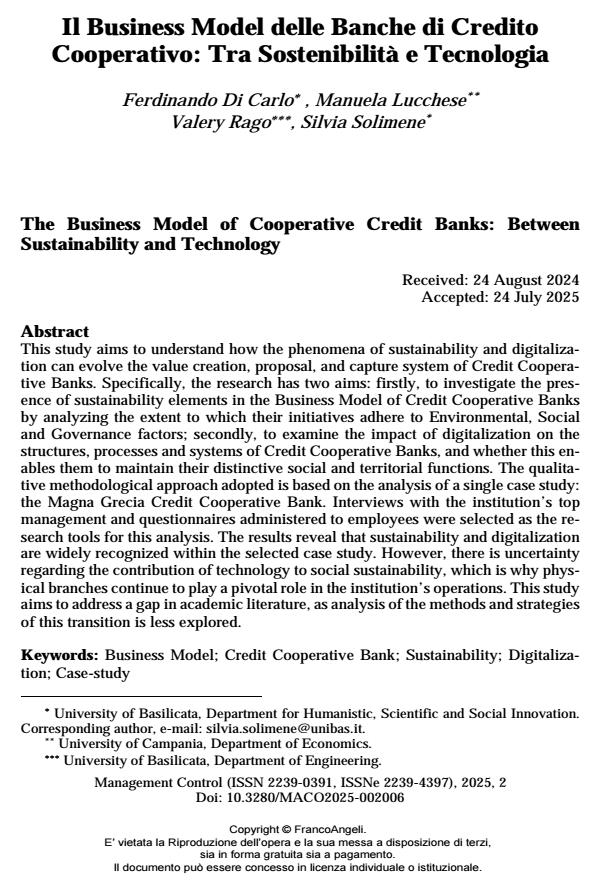Il Business Model delle Banche di Credito Cooperativo: Tra Sostenibilità e Tecnologia
Titolo Rivista MANAGEMENT CONTROL
Autori/Curatori Ferdinando Di Carlo, Manuela Lucchese, Valery Rago, Silvia Solimene
Anno di pubblicazione 2025 Fascicolo 2025/2
Lingua Italiano Numero pagine 24 P. 109-132 Dimensione file 142 KB
DOI 10.3280/MACO2025-002006
Il DOI è il codice a barre della proprietà intellettuale: per saperne di più
clicca qui
Qui sotto puoi vedere in anteprima la prima pagina di questo articolo.
Se questo articolo ti interessa, lo puoi acquistare (e scaricare in formato pdf) seguendo le facili indicazioni per acquistare il download credit. Acquista Download Credits per scaricare questo Articolo in formato PDF

FrancoAngeli è membro della Publishers International Linking Association, Inc (PILA)associazione indipendente e non profit per facilitare (attraverso i servizi tecnologici implementati da CrossRef.org) l’accesso degli studiosi ai contenuti digitali nelle pubblicazioni professionali e scientifiche
This study aims to understand how the phenomena of sustainability and digitalization can evolve the value creation, proposal, and capture system of Credit Cooperative Banks. Specifically, the research has two aims: firstly, to investigate the presence of sustainability elements in the Business Model of Credit Cooperative Banks by analyzing the extent to which their initiatives adhere to Environmental, Social and Governance factors; secondly, to examine the impact of digitalization on the structures, processes and systems of Credit Cooperative Banks, and whether this enables them to maintain their distinctive social and territorial functions. The qualitative methodological approach adopted is based on the analysis of a single case study: the Magna Grecia Credit Cooperative Bank. Interviews with the institution’s top management and questionnaires administered to employees were selected as the research tools for this analysis. The results reveal that sustainability and digitalization are widely recognized within the selected case study. However, there is uncertainty regarding the contribution of technology to social sustainability, which is why physical branches continue to play a pivotal role in the institution’s operations. This study aims to address a gap in academic literature, as analysis of the methods and strategies of this transition is less explored.
Parole chiave:Business Model; Credit Cooperative Bank; Sustainability; Digitalization; Case-study
Ferdinando Di Carlo, Manuela Lucchese, Valery Rago, Silvia Solimene, Il Business Model delle Banche di Credito Cooperativo: Tra Sostenibilità e Tecnologia in "MANAGEMENT CONTROL" 2/2025, pp 109-132, DOI: 10.3280/MACO2025-002006